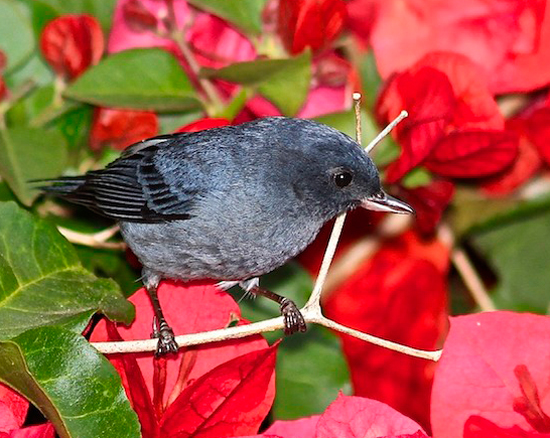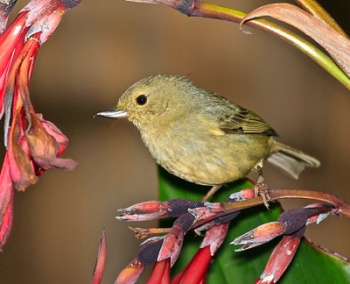- Diglossa plumbea
Identification
10cm.
Male is blue-grey with a lead-grey throat and breast. The tail and wings are black with grey feather edges. The female is olive-brown above with a paler throat and breast shading to buff on the belly. Young birds are like the female but have two tawny wing bars and faintly streaked buff-yellow underparts. An upturned bill with a hooked upper mandible and paler, pointed lower mandible.
Distribution
Costa Rica to western Panama.
Taxonomy
Two subspecies are recognized:
- D. p. plumbea - Highlands of Costa Rica and extreme w Panama (Chiriquí)
- D. p. veraguensis - Pacific slope of w Panama (Veraguas)
Some resources include the second subspecies within the nominate, treating the species as monotypic.
Habitat
Mountain forest canopy, edge of the forest, in clearings, and in gardens.
Behaviour
The birds approach a flower from behind, pierce a hole in the corolla, and then insert their brush-tipped tongue into the hole to extract the flower nectar, often without pollinating the flower.
The female builds a large cup nest of coarse plant material and lined with fine fibres, placed 0.4 to 4 m up in a dense shrub, grass tussock or pine. 2 brown-speckled pale blue eggs are laid, and are incubated by the female alone for 12-14 days to hatching.
References
- Clements, J. F., T. S. Schulenberg, M. J. Iliff, D. Roberson, T. A. Fredericks, B. L. Sullivan, and C. L. Wood. 2017. The eBird/Clements checklist of birds of the world: v2017, with updates to August 2017. Downloaded from http://www.birds.cornell.edu/clementschecklist/download/
- Gill, F & D Donsker (Eds). 2018. IOC World Bird List (v8.1). doi : 10.14344/IOC.ML.8.1. Available at http://www.worldbirdnames.org/.
- Angehr and Dean 2010: The birds of Panama - a field guide
- HBWalive queried July 2018
Recommended Citation
- BirdForum Opus contributors. (2024) Slaty Flowerpiercer. In: BirdForum, the forum for wild birds and birding. Retrieved 28 April 2024 from https://www.birdforum.net/opus/Slaty_Flowerpiercer
External Links
GSearch checked for 2020 platform.1





